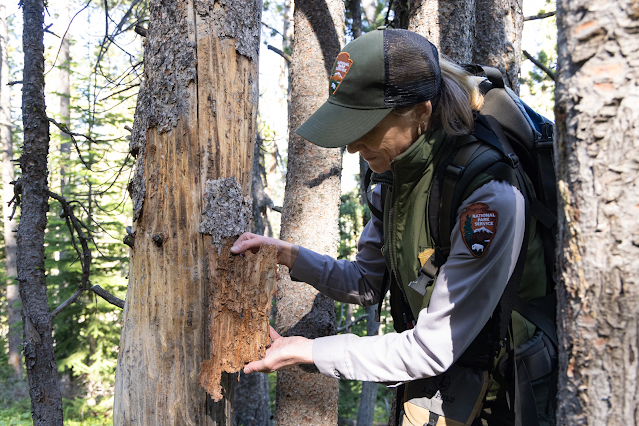Yellowstone Notebook
Inflation Reduction Act and Bipartisan Infrastructure Law invests $712,665 in restoration and resilience in Yellowstone and Grand Teton National Parks
Inflation Reduction Act and Bipartisan Infrastructure Law invests $712,665 in restoration and resilience in Yellowstone and Grand Teton National Parks
NPS / Jacob W. Frank
| Subscribe |
Contact: Morgan Warthin, (307) 344-2015
MAMMOTH HOT SPRINGS, WY – This year, Yellowstone and Grand Teton national parks received funding from the Inflation Reduction Act (IRA) as part of a nationwide effort to restore natural habitats and address climate change impacts. In fiscal year 2023, President Biden’s Investing in America agenda, through the Inflation Reduction Act and the Bipartisan Infrastructure Law, provided $52 million to the National Park Service to fund projects throughout the country related to ecosystem resilience, restoration, and environmental planning needs.To make the announcement today, Second Gentleman Douglas Emhoff and Assistant Secretary for Fish and Wildlife and Parks Shannon Estenoz visited Grand Teton National Park, where they toured sagebrush restoration work that will be supported by the investment.
Restoration efforts in Yellowstone and Grand Teton national parks will be focused on sagebrush and whitebark pine restoration as well as vulnerability of water supplies to climate change.
The Inflation Reduction Act is investing $1 million for on-the-ground sagebrush restoration in Grand Teton National Park and five other national parks. An additional $105,000 from the Bipartisan Infrastructure Law will help increase the availability and diversity of native plant seed needed for restoration. At Grand Teton, hayfields cultivated by homesteaders prior to park establishment are being restored to native sagebrush communities at a landscape-scale. This improves habitat quality and connectivity increasing resilience for pronghorn, bison, elk, mule deer, and greater sage grouse among other species in this iconic conservation landscape. Approximately $1 million of the funding will support removal of nonnative pasture grasses and expand native seed sources necessary for restoration. These funds leverage funding from Federal and philanthropic sources acquired over the past 15 years to achieve added value and amplify project effects at a landscape scale.
Whitebark pine is a high elevation pine species that grows in mountainous areas of the western US and Canada and provides important ecosystem services including snow retention, reducing erosion, providing cover for other tree species, and food and habitat for 19 wildlife species including the threatened grizzly bear. Whitebark pine has experienced significant declines range-wide in recent decades and was listed as threatened by the USFWS in January 2023. Yellowstone, Grand Teton, and John D. Rockefeller Jr. Memorial Parkway received Inflation Reduction Act funding in FY23 totaling $123,176 to implement conservation actions for whitebark pine. Three parks (Yellowstone National Park, Grand Teton National Park, and Glacier National Park) received $99,500 from the Bipartisan Infrastructure Law in FY23 to support these efforts. Using the National Whitebark Pine Restoration Strategy, these parks will work with other Federal, State, Tribal and nongovernment partners to plant blister rust resistant seed and seedlings, identify rust resistant trees for protection and seed source, monitor seedling survival, and identify climate refugia where whitebark pine conservation can be focused. These projects leverage over 20 years of effort at Glacier National Park, Yellowstone National Park, and Grand Teton National Park and will amplify conservation outcomes by allowing an adaptive, landscape-scale regional approach. Conserving whitebark pine forests through protection and restoration actions is key to the species persistence. Without these actions, threats from exotic white pine blister rust, mountain beetle infestations, and changing fire regimes, all of which are exacerbated by climate change, will result in irreversible loss of whitebark pine forests.
At parks across the country, including both Yellowstone and Grand Teton, another NPS project funded by IRA will assess the climate change vulnerability of park water supplies to increase the security and sustainability of NPS water for people, develop adaptation strategies, and inform investment decisions. Through working with partners, this project will complete all phases of ongoing pilot Climate Change Vulnerability Assessments (CCVAs) and expand efforts for additional parks with significant water supply improvement needs or suspected vulnerabilities.
The projects announced today infuse much-needed funding to put people to work addressing critical ecosystem needs to restore healthy and resilient park lands while benefiting communities surrounding parks. Through the Bipartisan Infrastructure Law and Inflation Reduction Act, the National Park Service is working to address the impacts of the climate crisis, including intensifying drought, wildfires, flooding and legacy pollution in national parks and other public lands. Resources are making significant strategic investments to repair critical facilities and infrastructure and enhance conservation through ecosystem restoration and recreation opportunities.
The full lists of fiscal year 2023 projects are available online: IRA Restoration and Resilience projects and BIL Ecosystem Restoration projects.
